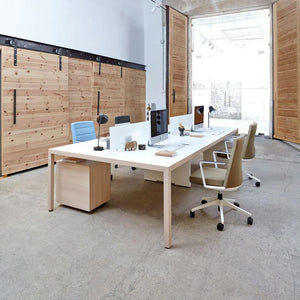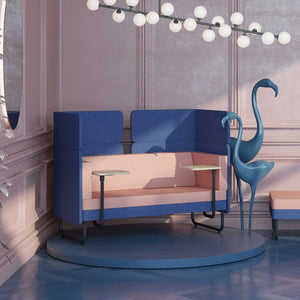
The Beginners Guide To Office Refurbishments
In today's fast-paced business world, the office environment plays a crucial role in the success and productivity of a company. An office refurbishment can provide a fresh and modern look, boost employee morale, and enhance overall efficiency. Whether you are a small start-up or an established company, it's essential to have a well-designed and comfortable workplace that aligns with your business goals. This beginner's guide will walk you through the essential aspects of office refurbishments, helping you make informed decisions and create a workspace that inspires success.

How to Choose the Right Office Furniture
When refurbishing your office, one of the key considerations is selecting the right furniture. Your office furniture not only serves practical purposes but also contributes to the overall aesthetic and comfort of the workspace. To make the right choice, it's crucial to consider factors such as functionality, ergonomics, style, and durability.
Functionality should be at the forefront of your furniture selection process. Think about the specific needs of your employees and how different pieces of furniture can support their tasks. From ergonomic chairs and adjustable desks to storage solutions, every item should serve a purpose and improve efficiency.
For example, when choosing desks, consider whether your employees require ample workspace for spreading out documents or if they need more storage space for files and supplies. Adjustable desks can accommodate different working preferences, allowing employees to switch between sitting and standing positions, promoting better posture and reducing the risk of back pain.
Ergonomics should never be overlooked when choosing office furniture. Investing in ergonomic chairs and adjustable desks can greatly enhance the comfort and well-being of your employees. Not only does this reduce the risk of musculoskeletal disorders, but it also boosts productivity and reduces absenteeism.
When selecting chairs, look for features such as adjustable seat height, lumbar support, and armrests. These features help maintain proper posture and reduce strain on the back and neck. Additionally, consider providing footrests to support proper leg positioning and reduce pressure on the lower back.
Style is another critical aspect to consider. The furniture you choose should align with your company's brand image and create a cohesive look throughout the office. Whether you prefer a sleek and modern design or a classic and traditional style, the furniture should reflect your company's personality and values.
Consider the overall colour scheme and design elements of your office space. Choose furniture that complements the existing décor and enhances the visual appeal of the workspace. For example, if your office has a minimalist aesthetic, opt for furniture with clean lines and neutral tones. On the other hand, if your company has a more vibrant and creative atmosphere, you can incorporate bold colours and unique designs into your furniture selection.
Lastly, don't forget about durability. Office furniture should be built to withstand daily wear and tear, as well as support the changing needs of your business. Opt for high-quality materials and reputable brands to ensure your investment stands the test of time.
Consider the expected lifespan of the furniture and the warranty provided by the manufacturer. Investing in durable furniture not only saves you money in the long run but also ensures that your employees have a reliable and comfortable workspace.
Additionally, think about the flexibility of the furniture. As your business grows and evolves, you may need to reconfigure your office layout or accommodate new employees. Look for furniture that can be easily rearranged or expanded to meet these changing needs.
In conclusion, choosing the right office furniture is a crucial part of creating a productive and comfortable workspace. By considering factors such as functionality, ergonomics, style, and durability, you can make informed decisions that benefit both your employees and your business. So take the time to research and explore different options, and invest in furniture that will support your company's success for years to come.
What to Consider When Planning an Office Refurbishment
An office refurbishment project requires careful planning to achieve the desired outcome. Before diving into the renovation process, consider the following factors to make sure your refurbishment aligns with your goals and budget.
The first step is to define your objectives. What do you want to achieve with the refurbishment? Is it to create a more collaborative workspace? Improve the flow of communication? Or perhaps enhance the visual appeal of the office? Clearly outlining your goals will help you prioritize tasks and allocate resources effectively.
Next, assess your budget. Determine how much you are willing to invest in the refurbishment project. Remember to factor in costs such as furniture, equipment, materials, and labour. It's wise to set aside a contingency budget for unforeseen expenses that may arise during the renovation process. Having a clear budget in mind will guide your decision-making and prevent overspending.
Consider the timeline of the project. Determine when it would be best to undertake the refurbishment, considering potential disruptions to your business operations. Depending on the scale of the project, you may need to plan for temporary relocations or adjust schedules to minimize disruptions. Efficient project management is key to ensuring a smooth transition without significant downtime.
Lastly, involve your employees in the planning process. Seek their input and feedback on what improvements they would like to see in the office. This not only fosters a sense of inclusiveness but also allows you to gain valuable insights into the needs and preferences of your team. Employee engagement plays a crucial role in the success of any office refurbishment project.
Managing Budgets and Schedules for Office Renovations

Managing budgets and schedules is a critical aspect of any office renovation project. Careful planning and efficient project management can help you avoid cost overruns and ensure the project stays on track.
Start by establishing a detailed budget breakdown. Divide your budget into categories such as furniture, fixtures, electrical work, painting, and labour. Allocate funds accordingly to reflect the priorities of your refurbishment project. Keep track of expenses throughout the renovation process to identify any deviations from the budget and take corrective measures if necessary.
Next, create a comprehensive schedule that outlines the timeline for different tasks and milestones. Identifying key deadlines and dependencies will help you manage the project effectively and ensure everything runs smoothly. It's important to factor in buffer time for unexpected delays or modifications to the initial plan.
Communication plays a vital role in managing budgets and schedules. Regularly communicate with your project team, contractors, and suppliers to ensure everyone is on the same page and aware of the project's progress. This open line of communication will facilitate prompt decision-making and prevent any misunderstandings that may impact the timeline or budget.
When it comes to procurement, consider working with trusted suppliers and contractors who have experience in office refurbishments. Their expertise and industry knowledge can help you source high-quality materials and furniture within your budget. Clear communication with suppliers is essential to avoid any delays or discrepancies in the delivery of goods.
Regular site visits and inspections are crucial to monitor the progress and quality of the renovation work. By staying involved and checking the work at different stages, you can quickly identify any issues or concerns and address them promptly, ensuring that the final result meets your expectations.
The Benefits of Office Refurbishments
Investing in an office refurbishment brings numerous benefits to both your business and your employees. Let's explore some of the advantages you can expect to gain:
- Enhanced Productivity: An improved office environment can boost employee productivity. By creating a well-designed space that supports specific tasks, you can optimize workflow and minimize distractions.
- Increased Employee Morale: A modern and comfortable workplace positively impacts employee morale and satisfaction. By investing in their well-being and creating an enjoyable work environment, you can foster a sense of pride and loyalty among your team.
- Improved Collaboration: Office refurbishments often include rethinking the layout and design to promote collaboration. Open workspaces, breakout areas, and meeting rooms facilitate communication and teamwork, leading to enhanced productivity and innovation.
- Attract and Retain Talent: A well-designed office can be a powerful tool in attracting and retaining top talent. Jobseekers are increasingly considering the work environment when choosing a company, and a modern, comfortable office can set you apart from competitors.
- Brand Image and Impressions: Your office is a reflection of your brand and company culture. A professionally refurbished office creates a positive impression on clients, visitors, and potential business partners, reinforcing your brand image and professionalism.
Creating an Ergonomic and Comfortable Work Environment
Employee comfort and well-being should be a top priority when refurbishing your office. By creating an ergonomic and comfortable work environment, you can enhance productivity, reduce absenteeism, and promote overall employee satisfaction.
Ergonomics focuses on designing workspaces that reduce the risk of musculoskeletal disorders and improve overall comfort. Consider investing in adjustable desks and ergonomic chairs that can be customized to fit each employee's individual needs. Provide proper lighting to reduce eye strain and encourage natural light where possible. Additionally, consider installing noise-absorbing materials to minimize distractions and create a calm working atmosphere.
Encourage movement and promote a healthy workplace by incorporating breakout areas, standing desks, and wellness rooms. Encouraging employees to take breaks and engage in physical activities throughout the workday can significantly contribute to their well-being and productivity.
Consider incorporating greenery and natural elements into your office refurbishment. Research has shown that exposure to nature can reduce stress levels and improve cognitive function. Adding plants, green walls, or even large windows with views of nature can create a refreshing and calming atmosphere.
Lastly, create designated areas for relaxation and socialization. Breakout areas with comfortable seating, kitchenettes, and communal spaces can provide employees with a place to unwind, collaborate, and connect with colleagues. Prioritizing employee well-being will not only result in a more productive workforce but will also foster a positive company culture.
In conclusion, office refurbishments can have a profound impact on your business's success and the well-being of your employees. By carefully considering factors such as furniture selection, planning, budget management, and creating a comfortable work environment, you can create a workspace that inspires productivity, collaboration, and success. Keep in mind that office refurbishments are an ongoing process, and periodically reviewing and updating your workspace will ensure it continues to meet the evolving needs of your business.


